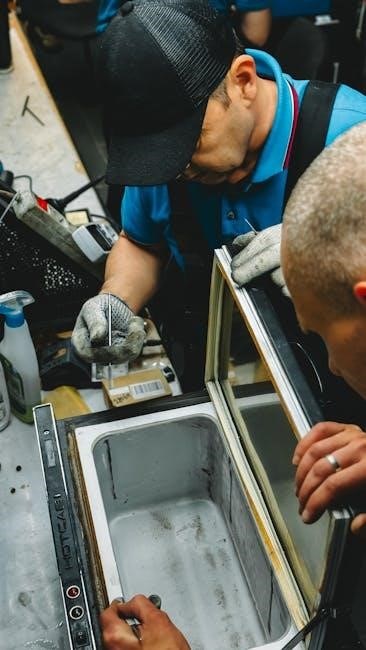Manual gearboxes, while reliable, can develop issues like oil leaks, shifting difficulties, and unusual noises․ Addressing these problems early prevents costly repairs and ensures smooth operation․
1․1 Overview of Manual Transmission Components
A manual gearbox consists of key components like gears, bearings, synchronizers, and the clutch․ These parts work together to transfer power from the engine to the wheels․ The gears and bearings enable smooth torque transmission, while synchronizers facilitate seamless gear shifts․ The clutch connects and disconnects power flow, allowing manual shifting․ Proper functionality of these components is crucial for efficient operation․ Any failure or wear in these parts can lead to common issues like difficulty shifting or unusual noises, emphasizing the importance of regular maintenance and inspection․
1․2 Importance of Regular Maintenance
Regular maintenance is essential to extend the lifespan of a manual gearbox and prevent costly repairs․ Checking transmission fluid levels, inspecting for leaks, and ensuring proper lubrication are critical tasks․ Timely replacement of worn components, such as the clutch and synchronizers, can prevent major issues․ Neglecting maintenance often leads to premature wear, difficult shifting, and unexpected failures․ Consistent upkeep ensures smooth operation, reduces the risk of breakdowns, and maintains optimal vehicle performance․ A well-maintained gearbox enhances driving experience and reduces long-term ownership costs․

Common Manual Gearbox Issues
Common issues include oil leakage, shifting difficulties, unusual noises, gears not engaging, and burning smells․ These problems often stem from wear, lack of maintenance, or component failure․
2․1 Oil Leakage from the Manual Gearbox
Oil leakage from a manual gearbox is a common issue, often caused by damaged seals, gaskets, or worn-out components․ It can lead to reduced lubrication, causing friction and potential gearbox failure․ Regular inspection of seals and gaskets is crucial to prevent leaks․ If left unaddressed, leakage can result in costly repairs, including replacing damaged parts․ Proper maintenance, such as timely replacement of worn seals, helps prevent this issue and ensures smooth gearbox operation․ Addressing leaks early is essential to avoid further complications․
2․2 Difficulty in Shifting Gears
Difficulty in shifting gears is a frequent issue in manual transmissions, often caused by low fluid levels, worn synchronizers, or misaligned components․ Improper clutch usage can also contribute, as can faulty linkages or shift forks․ Early detection is crucial, as persistent problems may lead to costly repairs․ Regular maintenance, such as fluid checks and component inspections, can help prevent these issues․ Addressing shifting difficulties promptly ensures smooth operation and extends the gearbox’s lifespan, avoiding major breakdowns․
2․3 Unusual Noises (Grinding, Whining, Clunking)
Unusual noises from a manual gearbox, such as grinding, whining, or clunking, often indicate internal wear or damage․ Grinding sounds may suggest worn gears, while whining could point to faulty bearings․ Clunking noises might signal issues with the clutch or drivetrain components․ These noises can escalate if ignored, leading to more severe damage; It’s essential to diagnose the source promptly, as early intervention can prevent costly repairs and ensure the transmission operates smoothly․ Regular inspections and lubrication can help mitigate these issues․ Addressing noises early is key to maintaining gearbox health․
2․4 Gears Not Engaging Properly
Gears not engaging properly is a common issue in manual transmissions․ This problem can stem from worn-out synchronizers, low transmission fluid levels, or a faulty clutch․ If gears fail to engage smoothly, it can lead to difficulty in accelerating or maintaining speed․ Ignoring this issue may result in further damage to internal components․ Regular checks of fluid levels and clutch operation are crucial to prevent such problems․ Addressing this early can avoid costly repairs and ensure smooth gear transitions, maintaining optimal vehicle performance and driver control․ Prompt attention is essential to avoid escalating gearbox damage․

2․5 Burning Smell from the Transmission
A burning smell from the transmission is a concerning symptom that often indicates overheated components․ This can occur due to clutch drag, where the clutch fails to disengage fully, causing excessive heat buildup․ Additionally, insufficient transmission fluid or degraded lubrication can lead to friction and overheating of internal parts․ If left unaddressed, this issue may result in severe damage to gears, bearings, or other components․ It is crucial to investigate and resolve this problem promptly to prevent costly repairs or even complete transmission failure, ensuring the vehicle’s longevity and performance remain intact․

Causes of Manual Gearbox Problems
Manual gearbox issues often arise from low fluid levels, worn components like synchronizers, misalignment, or improper clutch usage, leading to malfunction and requiring prompt attention․
3․1 Low Transmission Fluid Levels
Low transmission fluid levels are a common cause of manual gearbox problems․ Insufficient lubrication can lead to increased friction between moving parts, causing wear and tear․ This can result in difficulty shifting gears, grinding noises, and eventual component failure․ Regular fluid checks are essential to maintain optimal levels and prevent damage․ Always use the recommended type of transmission fluid to ensure proper lubrication and longevity of the gearbox components․ Neglecting fluid levels can lead to costly repairs down the line․
3․2 Worn-Out Internal Components (Synchronizers, Bearings)
Worn-out internal components, such as synchronizers and bearings, are a major cause of manual gearbox issues․ Over time, these parts wear down due to friction and stress, leading to grinding noises, difficulty shifting gears, and improper engagement; If left unaddressed, this can result in complete gearbox failure, requiring an overhaul․ Replacing these components early is crucial to maintain smooth operation and prevent further damage to the transmission system․ Regular inspection and maintenance can help identify wear before it becomes a serious problem․
3․3 Misalignment of the Transmission
Misalignment of the transmission is a common issue that can lead to premature wear and gearbox failure․ This occurs when the transmission is not properly aligned with the engine or drivetrain, causing uneven stress on internal components․ Symptoms include vibrations, abnormal noises, and difficulty shifting gears․ Misalignment can result from improper installation, chassis flex, or accidental damage․ If left uncorrected, it can lead to catastrophic failure of gears, bearings, and other critical parts․ Proper alignment during installation and regular checks are essential to prevent this issue․
3․4 Improper Clutch Usage
Improper clutch usage is a significant contributor to manual gearbox problems․ Riding the clutch or failing to engage it fully can cause excessive wear on the clutch assembly and synchronizers․ This leads to difficulty shifting gears, grinding noises, and eventual failure of the clutch or gearbox․ Aggressive driving habits, such as sudden acceleration or deceleration, can also strain the clutch and transmission․ Regular maintenance and proper driving techniques are essential to prevent these issues and extend the lifespan of the gearbox and clutch system․

Diagnosis of Gearbox Issues
Diagnosing manual gearbox problems involves identifying symptoms like unusual noises, shifting difficulties, or fluid leaks․ Inspections and tests help pinpoint issues before they escalate, ensuring timely repairs․
4․1 Identifying Symptoms of Gearbox Failure
Identifying symptoms of gearbox failure involves noticing unusual noises, such as grinding, whining, or clunking, which often indicate worn bearings or gears․ Difficulty shifting gears, slipping out of gear, or a burning smell are also common signs․ Leaks in the transmission fluid can lead to low fluid levels, causing improper lubrication and further damage․ Early detection of these symptoms is crucial to prevent complete gearbox failure and costly repairs․ Regular inspections and monitoring driving behavior help in catching issues early․
4․2 Basic Troubleshooting Steps
Start by checking the transmission fluid level and condition, as low or degraded fluid can cause shifting issues․ Inspect for leaks around seals and gaskets․ Test the clutch operation to ensure it disengages fully․ Listen for unusual noises during gear shifts or when the vehicle is in neutral․ Check the gear linkage for loose connections or damage․ If issues persist, test the gearbox under load to identify slipping or hesitation․ These steps help pinpoint the root cause of the problem before advanced diagnostics or repairs are needed․

Repair and Maintenance Tips
Regular fluid changes, inspecting for leaks, and replacing worn components like the clutch and pressure plate can prevent major issues․ Rebuilding the gearbox may be necessary for severe damage, while timely maintenance ensures optimal performance․
5․1 Replacing the Clutch and Pressure Plate
Replacing the clutch and pressure plate is essential when they show signs of wear or failure, such as slipping, dragging, or difficulty engaging gears․ A damaged clutch can lead to poor transmission performance and potentially cause further internal damage․ The process involves removing the gearbox, inspecting components, and installing new parts․ Proper alignment and adjustment are crucial for smooth operation․ Regular inspection and timely replacement can prevent costly repairs and ensure optimal gear engagement and driving experience․
5․2 Rebuilding the Gearbox
Rebuilding the gearbox is a comprehensive solution for severe internal damage․ It involves disassembling the unit, cleaning, and replacing worn components like bearings, gears, and synchronizers․ This process restores the gearbox to optimal performance and prevents further deterioration․ While rebuilding is cost-effective, it requires mechanical expertise and time․ Proper reassembly and alignment are critical to ensure smooth operation․ Using high-quality replacement parts ensures durability and reliability, making it a viable option for extending the gearbox’s lifespan and maintaining vehicle performance․
5․3 Regular Fluid Changes
Regular fluid changes are essential for maintaining the health of a manual gearbox․ Transmission fluid lubricates gears and prevents overheating, ensuring smooth operation․ Over time, the fluid can degrade or become contaminated, leading to increased wear and potential damage․ Changing the fluid every 30,000 to 60,000 miles, depending on usage, helps maintain optimal performance․ Always use the correct type of fluid recommended by the manufacturer to avoid compatibility issues․ Proper fluid maintenance prevents premature wear and extends the gearbox’s lifespan, ensuring reliable and smooth shifting․

Preventative Measures
Preventative measures for manual gearboxes include regular fluid inspections, avoiding aggressive driving, proper clutch usage, and promptly addressing early signs of wear to prevent issues․
6․1 Proper Driving Techniques
Proper driving techniques are essential to prevent manual gearbox issues․ Smooth acceleration, gradual braking, and avoiding aggressive driving reduce wear on internal components․ Correct use of the clutch, such as not riding it, prevents premature wear on the pressure plate and release bearing․ Shifting gears at appropriate RPMs avoids strain on synchronizers and bearings, reducing the risk of grinding or clunking noises․ Avoiding sudden shifts and not overloading the vehicle further protects the gearbox from unnecessary stress․ Regular fluid checks and adherence to maintenance schedules ensure longevity and optimal performance of the manual gearbox․
6․2 Scheduled Maintenance Checks
Scheduled maintenance is crucial for preventing manual gearbox issues․ Regular fluid changes ensure optimal lubrication, reducing wear on gears and bearings․ Inspecting the clutch and transmission mounts helps identify potential problems early․ Checking for leaks and worn-out seals prevents fluid loss and contamination․ Replacing the transmission filter and ensuring proper gear alignment are also vital․ Adhering to the manufacturer’s service intervals guarantees the gearbox operates smoothly and prolongs its lifespan․ Neglecting these checks can lead to costly repairs and premature failure of critical components․
Manual gearbox problems, such as oil leaks, shifting difficulties, and unusual noises, can significantly impact driving performance․ Early detection and proper maintenance are key to preventing major repairs․ Regular fluid changes, clutch inspections, and addressing worn components can extend gearbox lifespan․ Proper driving techniques and scheduled checks ensure smooth operation․ By understanding common issues and adopting preventative measures, drivers can avoid costly breakdowns and maintain optimal vehicle performance․ Consistent care and attention are essential for the longevity and reliability of a manual gearbox․